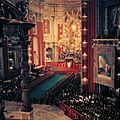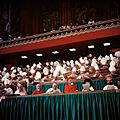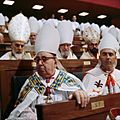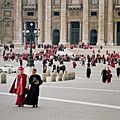Second Vatican Council facts for kids
Quick facts for kids Second Vatican Ecumenical CouncilConcilium Oecumenicum Vaticanum Secundum (Latin) |
|
|---|---|
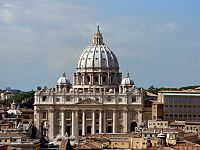
Saint Peter's Basilica
Venue of the Second Vatican Council |
|
| Date | 11 October 1962 – 8 December 1965 |
| Accepted by | Catholic Church |
|
Previous council
|
First Vatican Council (1869-1870) |
| Convoked by | Pope John XXIII |
| President | Pope John XXIII Pope Paul VI |
| Attendance | up to 2,625 |
| Topics | The Church in itself, its sole salvific role as the one, true and complete Christian faith, also in relation to ecumenism among other religions, in relation to the modern world, renewal of consecrated life, liturgical disciplines, etc. |
|
Documents and statements
|
Four constitutions:
Three declarations:
Nine decrees:
|
| Chronological list of ecumenical councils | |
The Second Vatican Council, often called Vatican II, was a very important meeting for the Catholic Church. It was the 21st Ecumenical Council in the Church's history. Pope John XXIII started it in 1962, and it ended in 1965 under Pope Paul VI.
Many people believe these meetings were the most important event for the Catholic Church in the 20th century. They led to many changes, like allowing Mass to be said in local languages instead of only Latin. The council aimed to update the Church and help it connect better with the modern world. It also worked on building bridges with other religions.
Contents
What Was Vatican II?
Vatican II was a series of meetings where leaders of the Catholic Church came together. These leaders included bishops, cardinals, and popes. They discussed how the Church could better serve its members and the world. The council took place in Vatican City, at St. Peter's Basilica.
Who Attended the Council?
Many important people attended Vatican II. Up to 2,625 bishops and other Church leaders were there. Four future popes were present at the start of the council:
- Cardinal Giovanni Battista Montini, who became Pope Paul VI.
- Bishop Albino Luciani, who later became Pope John Paul I.
- Bishop Karol Wojtyła, who became Pope John Paul II.
- Father Joseph Ratzinger, who was a young expert helping the council. He later became Pope Benedict XVI.
Why Was the Council Held?
The main goal of Vatican II was to bring the Catholic Church up to date. This idea is called aggiornamento, which means "bringing up to date" in Italian. The Church wanted to respond to the big changes happening in the world after World War II. It also wanted to talk more openly with other Christian groups and non-Christian religions.
Key Changes and Decisions
The Second Vatican Council produced many important documents. These documents guided the Church in making changes. They covered topics like how Mass is celebrated, how the Church sees itself, and how it relates to the modern world.
Changes to Mass and Worship
One of the most noticeable changes was to the Mass. Before Vatican II, Mass was almost always said in Latin. After the council, Mass could be celebrated in the local language of the people. This made it easier for people to understand and participate. Priests also began to face the congregation more often during Mass.
The Church and the World
The council talked a lot about the Church's role in the modern world. It encouraged Catholics to be more involved in society and to work for justice and peace. It also stressed the importance of religious freedom for everyone.
Relations with Other Religions
Vatican II opened up new ways for the Catholic Church to talk with other Christian churches and other religions. This effort is called ecumenism. The council taught that there is truth and goodness in other faiths, and it encouraged respect and understanding among all people.
Impact of Vatican II
The Second Vatican Council had a huge impact on the Catholic Church. It changed how Catholics worship, how they see their faith, and how the Church interacts with the world. While some changes were welcomed, others led to discussions and different opinions within the Church. Overall, Vatican II aimed to make the Church more open, relevant, and connected to people's lives.
Images for kids
-
A Catholic priest celebrating Tridentine Mass, the form of the Mass prevalent before the council, showing the chalice after the consecration.
-
Paul VI presiding over the introductory ingress of the council, flanked by Cardinal Alfredo Ottaviani (left), Cardinal Camerlengo Benedetto Aloisi Masella and Monsignor Enrico Dante (future Cardinal), Papal Master of Ceremonies (right), and two Papal gentlemen.
-
The abolition of Friday of Sorrows of the Virgin Mary is an example of changes in the Liturgical Calendar after the council. The Virgin of Hope of Macarena, Spain.
See also
 In Spanish: Concilio Vaticano II para niños
In Spanish: Concilio Vaticano II para niños


